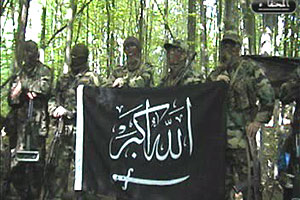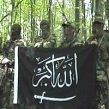
The Yarmuk Jamaat and the Sochi Olympics
Publication: Eurasia Daily Monitor Volume: 10 Issue: 69
By:

The Yarmuk jamaat in Kabardino-Balkarian and the Karachay jamaat in Karachaevo-Cherkessia are among the jamaats that cause the Russian security services the most concern. The Karachay jamaat is currently in a dormant stage due to the losses it suffered at the hands of the Russian security services in 2005–2007 (https://studies.agentura.ru/to/russia/kchr/). By contrast, the Yarmuk jamaat’s activities took off as it practically replaced the Karachay jamaat in the region during the same period of 2005–2007. This development prompted the leader of the North Caucasian militants to unite both regions into one in his virtual entity of the Caucasus Emirate—the vilayet of Kabarda, Balkaria and Karachay (www.kavkazcenter.com/russ/content/2007/12/10/54917.shtml). Doku Umarov did not hide his grandiose plans to include the Krasnodar region in the Caucasus Emirate as well (https://kavkaz.tv/russ/content/2010/03/08/71087.shtml). Umarov emphasized that these lands belonged to “Adygs, Abazins, Circassians,” as he attempted to attract Circassians to his cause, especially Circassians living outside Russia.
The Yarmuk jamaat has existed practically since the start of the second Chechen war. Initially, its members were people who had fought alongside Shamil Basaev. The jamaat’s activities were at their peak during the leadership of Emir Seifullah (a.k.a. Anzor Astemirov), who was killed on March 24, 2010. Astemirov essentially became the leader of the entire Caucasus Emirate as he ascended to one of the highest positions in the hierarchy of the militants—the sharia judge of the Emirate. He became not simply the judge in the Caucasus Emirate, but its principal ideologue. It was Astemirov who insisted on transforming the movement for Ichkeria’s independence into a pan–North Caucasus jihadi movement (https://kavkasia.net/Russia/article/1357869979.php). During Astemirov’s leadership, laying improvised explosive devices (IEDs) featured very prominently in the rebels’ activities: in 2010; for example, there were approximately 41 explosions while 26 others were prevented (www.kavkaz-uzel.ru/articles/179695/).
The Kabardino-Balkarian jamaat was one of the most active in the region from 2007 to 2010. Its activities peaked in 2010. Thus, in the course of only 50 days from June 1 to July 20, there were at least 17 explosions and eight gun attacks on law enforcement agents (https://kabardino-balkaria.kavkaz-uzel.ru/articles/172027/). This happened despite the fact that by this time, the jamaat had practically lost all of its top leaders. The then–Russian Interior Minister Rashid Nurgaliev stated at a government meeting in the city of Pyatigorsk on November 29, 2010: “In the current year, there were six times more gun attacks in Kabardino-Balkaria than in the same period last year, and there were five times more bomb attacks” (www.arms-expo.ru/050049054050124049057053051048.html).
Judging by the frequency of the subsequent killings of the leaders of the jamaat in 2010–2012, it can be deduced that the security services had a mole in the ranks of the militants. The last collective killing of the leadership of the jamaat took place on September 20, 2012, when the Kabardino-Balkarian militants lost four emirs—sector commanders—along with four lower ranking rebels. These losses put the jamaat in a difficult position, as its members had to engage in a long and cumbersome process of cautiously restoring ties to each other (https://www.rg.ru/2012/09/20/reg-skfo/nalch.html).
Despite the fact that the militants’ activities were at a much lower level in 2012 than in 2010, this jamaat still remains a headache for the federal authorities. According to the former interior minister, “The situation in Kabardino-Balkaria is stabilizing and this dynamic is acquiring a permanent character.” The authorities, however, are concerned not so much about the situation inside this republic as about its impact on the neighboring territories. This question is especially important because of the upcoming 2014 Winter Olympic Games that are scheduled to take place in Sochi in ten months. It is not the physical proximity of Kabardino-Balkaria to Sochi that worries the security services. In fact, the distance between the republic and Sochi is relatively significant even by Russian standards—almost 700 kilometers via the Armavir-Maikop-Tuapse highway, which can be covered in about eight hours by car. Direct access via the mountains is twice as close, but the mountainous route is difficult because of the terrain (www.avtodispetcher.ru/distance/?from=%D0%9D%D0%B0%D0%BB%D1%8C%D1%87%D0%B8%D0%BA&to=%D0%A1%D0%BE%D1%87%D0%B8).
Why then are the authorities so concerned about the safety of the Olympic Games? It is unlikely that militants from Chechnya or Dagestan will travel to Sochi to stage attacks. The region of Sochi is an area that historically belonged to the Circassian highlanders, in particular to the multiple Circassian groups. As the Russian-Circassian war was ending in May 1864, the Russian government drove practically all of the local population out of the area. So all this territory, which used to be populated by Circassians, today belongs to the Cossacks who settled there as the Circassians were forcibly deported to the Ottoman Empire. Therefore, the Circassian question, which has been ignored by the Russian government from the very inception of the plan to hold the Winter Olympics in Sochi, could explode. The Black Sea Adygs (a.k.a. Shapsugs) are the Circassian group that lives closest to Sochi, and the republic of Adygea is also nearby. However, neither the Shapsugs nor the residents of Adygea have any allegiance to jihadism. Yet, no one can discount the possibility that, as the activities of the Circassian diaspora increase, the Circassians in the North Caucasus might rise up to restore historical justice. After all, there is only one step that separates jihadism from ardent nationalism and separatism. In the past, the Federal Security Service (FSB) reported foiling terrorist attacks at the Olympic sites in Sochi (www.firstnews.ru/articles/doku-umarovu-ne-dali-proyavit-sebya-na-olimpiade-v-sochi/), so there are no guarantees that it will not happen again.
Lastly, while there is the theoretical possibility of North Caucasian militants attacking the Olympic site, the chances they would do so from Kabardino-Balkaria or Karachaevo-Cherkessia are minimal. Still, the Yarmuk jamaat may try to show that it is still active and use the games as a reminder of its existence by carrying out an attack. Despite the low level of risk, the Russian authorities cannot feel safe and will continue to build up military and security forces in the region in order to avoid any unexpected developments in the period from the end of 2013 to the end of the Olympics in 2014.




